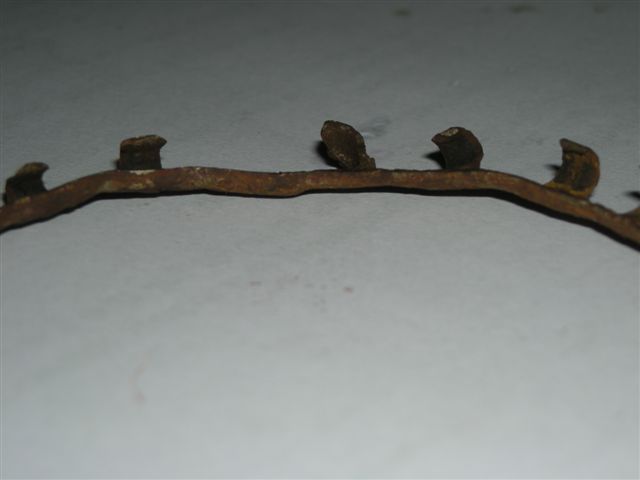Mangled Shimano Hub Gear Innards
This is the result of dismantling a broken Shimano SG-8R25 hub gear after about two years of daily commuting use. That is, it's used 5 days a week, year-round, for a journey about 6 miles each way. It lives under cover at both ends, so it has never been left out in the rain, though it obviously gets ridden in the rain (I don't take the day off work just because it is raining).
It had been running rough for a while (a few weeks).
It went clonk, and started dragging the pedals round. I found that if I
tried to pedal, it tended to seize up (very hard work to drive it round). If
I tried to free-wheel, it tried to pull the pedals round (but you could resist
with not too much effort). However, if you walked it, and allowed the cranks
to rotate, it wheeled along quite easily
... so I walked the rest of the way to work.
Dismantling
When the opportunity arose, I took it apart, and this is what I found. Those of a mechanically sensitive nature should probably look no further...
This is with the innards out of the shell, and the bits that (literally) fell to hand. I identified about half as many ball-bearings as I should have, a horribly mangled bearing carrier, a bent bit of wire and a little ratchetty pawl thing. The innards were coated in muddy gunk.
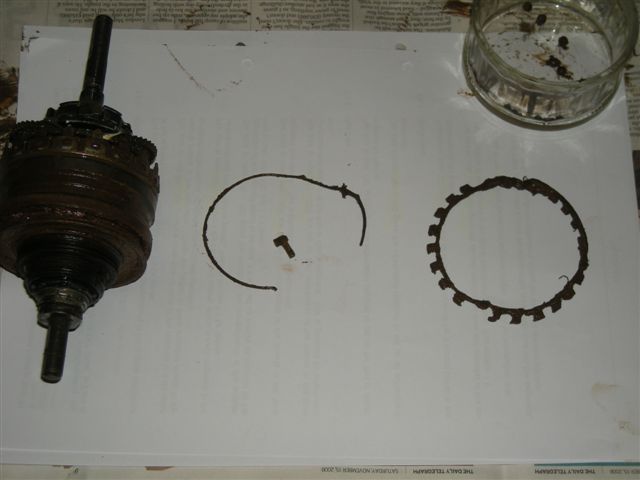
Yes, that ball carrier is mangled. Some more ball bearings come to light, however.
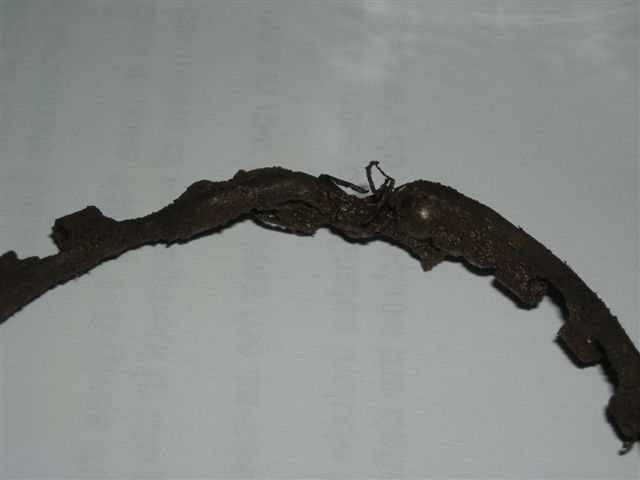
A bent bit of wire, quite difficult to straighten (or at least, bend to a smooth circle). Pawl doesn't look too bad.
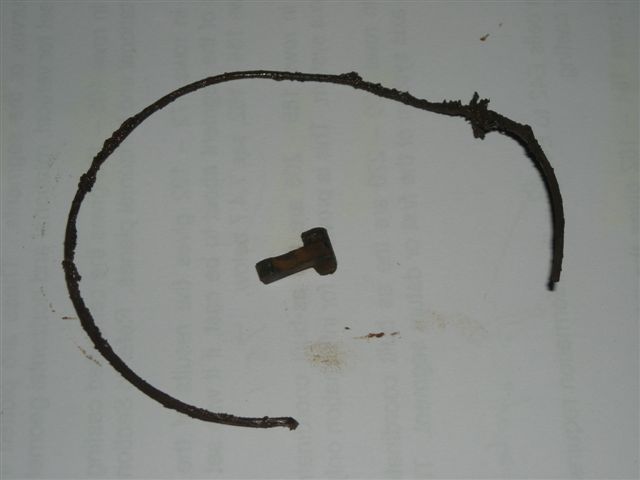
Consider what didn't fall out. Mud-coloured gunk where we should have nice clean grease. Water droplets. Moderate pitting on various surfaces (including cup and cone).
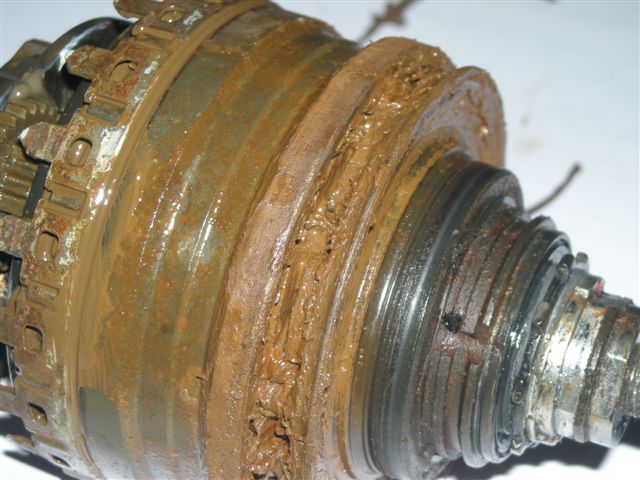
Looking inside, I find some more ball bearings. I don't imagine these are supposed to be nestled neatly in the teeth of that cog...
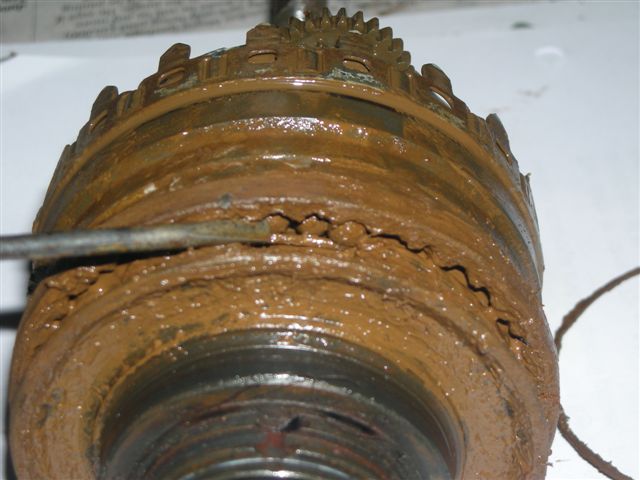
Wiped some mud off. You can see the horrible surface remaining on the cone here (at the left end of the largest diameter section). Also, that large diameter section should have some play - it should rotate freely and move left and right a bit. It doesn't - it's jammed solid.
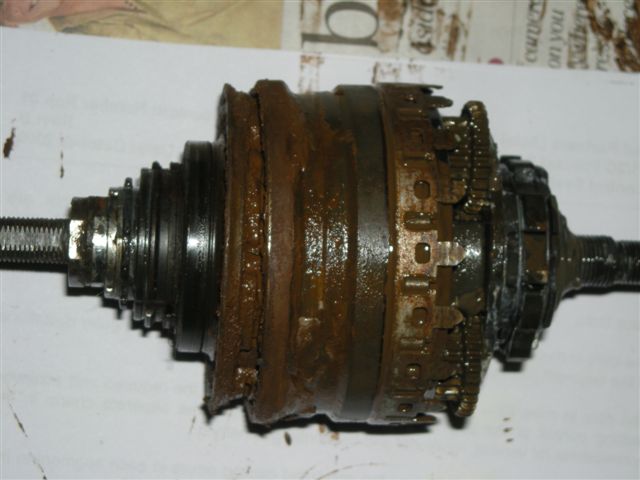
And another thing. These bits should all be concentric, the cone should be parallel to the carrier - so the gap to the left should be the same size as the gap to the right... That cone looks worse and worse.
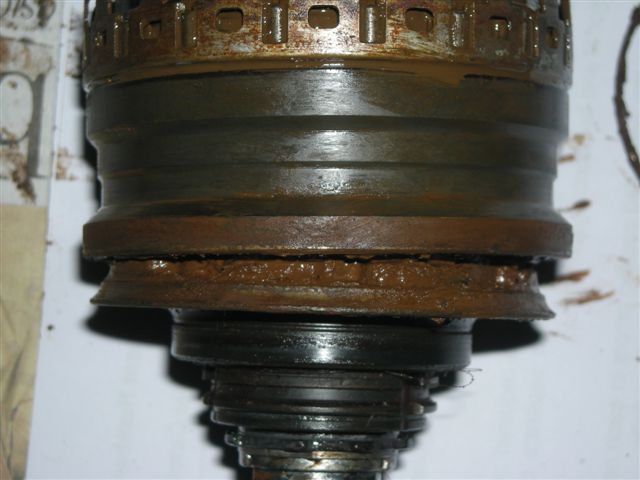
A bit more work actually did get the carrier (the biggest diameter bit) off the axle. This released more ball bearings (those which were jammed in the teeth) and another pawl. Sadly, this pawl suggested that that pawl was not quite as it should be:
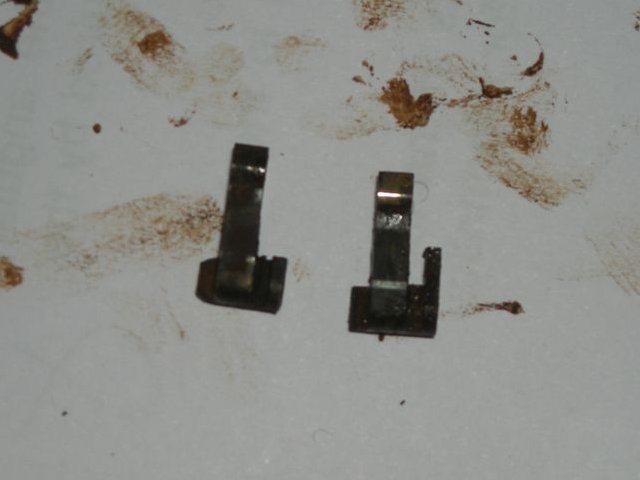
Two pawls of a set of four fell out. These pawls seem to be in two pairs. All four are aligned by a pair of wire rings in grooves, but each wire provides the springing to two of them. That is, two wires, each of which guides all four pawls, but only provides springiness to two. That bent bit of wire was one of springs. I bent it back to smooth circle, and fitted the one intact pawl back into place.
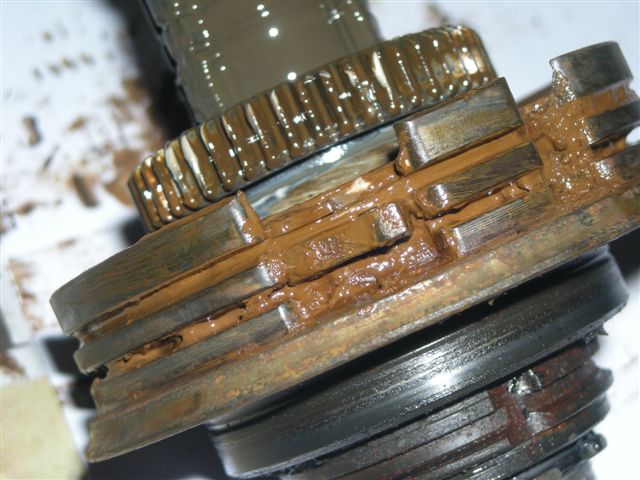
Pawl in place
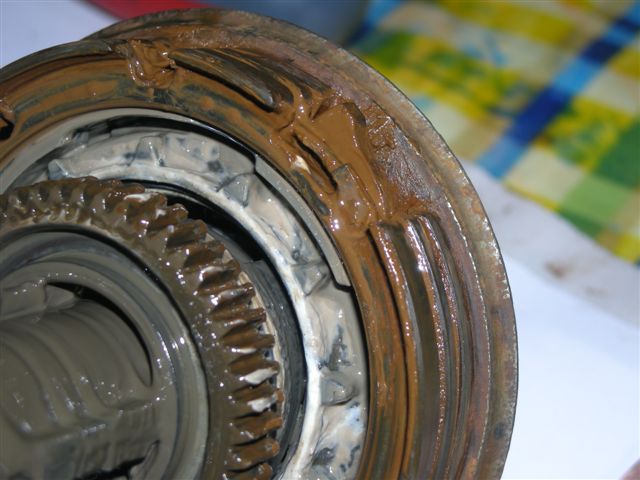
About the only good news is that I found all 26 balls. Admittedly, they aren't in a very good state, but at least none of them have turned to shrapnel and worked their way deeply into the innards.
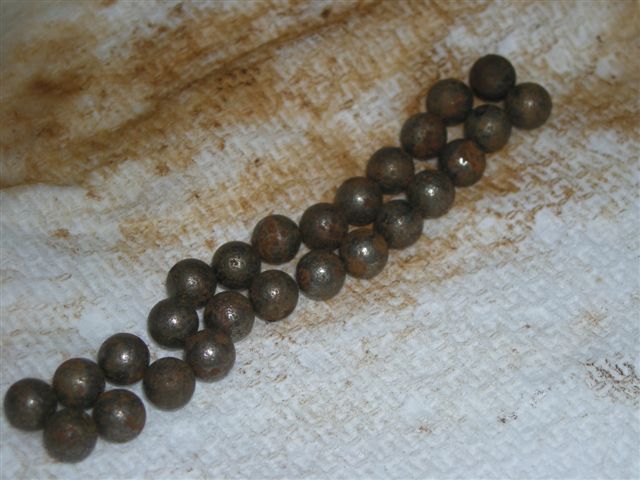
So I put it all back together, less one pawl (so I have three out of four, but one doesn't work, so only two out of four really) and the ball bearings (and carrier - I couldn't unfold that). With fewer than designed pawls it would probably work. If I can get a new ball retainer the hub may well be functional, but that's not an easy thing to source.
However, the spring I bent back to shape is not properly back to shape, so I'm not convinced it is properly supporting the two pawls. I'm not heavy, and I don't ride hard - I think two pawls would be enough if those two were properly supported. I'm nervous that two pawls designed to be held on each side and actually only held on one side will twist under load and eject themselves from where they are supposed to be. (Btw, this isn't the freewheel ratchet, I think, - there's another chunkier ratchet at the other end of the hub).
Diagnostic Speculation
But I've been looking at the pawl (under 10x magnification). I don't think it broke in this event - I think it is possible it was never right.
From the pictures above, I think a bit is missing. I think it is clear that the two that came out should be identical - there are four pawls, two are identical to each other, one is a mirror image of those two, and the fourth is identical to the third but for an absent leg. You can see one of the two that remained in the hub in the pictures.
However, the three that are the same / mirror image all have wear across the full face at the tip - you can see that in the photo. The 'broken' one has the tiniest bit of wear, and it's decidedly eccentric on the face - to the extent that there's a waxy build-up on one side of the face. I don't think the 'broken' pawl has ever been engaging significantly.
Next, I've looked at what would be the fracture face if that leg had broken off. If it ever broke off, it did so long ago. In fact, I'm pretty much certain the black surface treatment over the pawl extends across that fracture face - ie, it broke off during pawl manufacture, before the surface coating process, and was put into the hub broken.
I think I've got a combination of two events:
1: water got in, rust formed, balls pitted, race surfaces pitted and this is what was making the hub run rough. Several people have reported rough-running Shimano hub gear and nasty brown gunk inside. I think Shimano's sealing is not all it's cracked up to be. (FWIW, I think the weak point is where the axle assembly comes out through the plastic end-cap on the hub - I think that's where water gets in, and I'm not sure how to prevent it.)
But I don't think that's what crunched the hub. I think that was:
2: a faulty pawl was not engaging properly, and in particular was engaging slightly twisted. I don't know why it took two years to do it (maybe a bit of slop as something corroded, some cruddiness moving around) made the pawl twist, which was not prevented by the absent leg. The twisting pawl then jammed on the teeth and wrenched the spring that was holding it out of its groove and into the teeth. The spring is then suddenly wrenched around and tangles with the ball carrier, which pulls out and sheds balls.
I've had some correspondence with one other hub owner, who not only reported the same rough running and muddy interior (that seems common to lots of these hubs), but also a single broken pawl, mangled spring, and mangled carrier.
The ball carrier was quite thoroughly mangled. This is it subsequently cleaned up. Given the distortion, gouges and scrapes, it's no surprise that the hub had a tendency to jam solid.
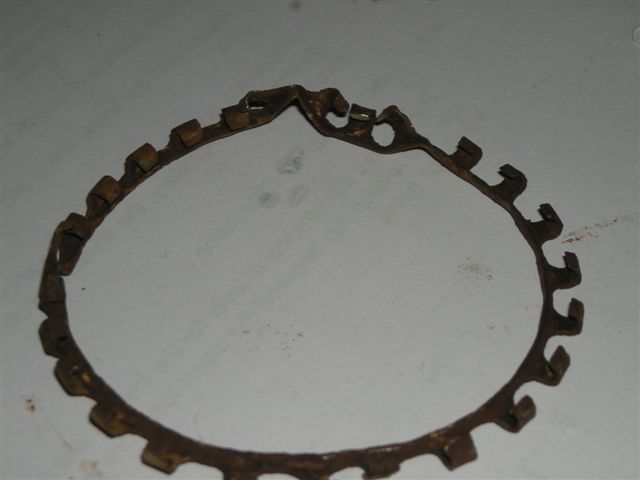
This is at about 12'o'clock on the picture above.
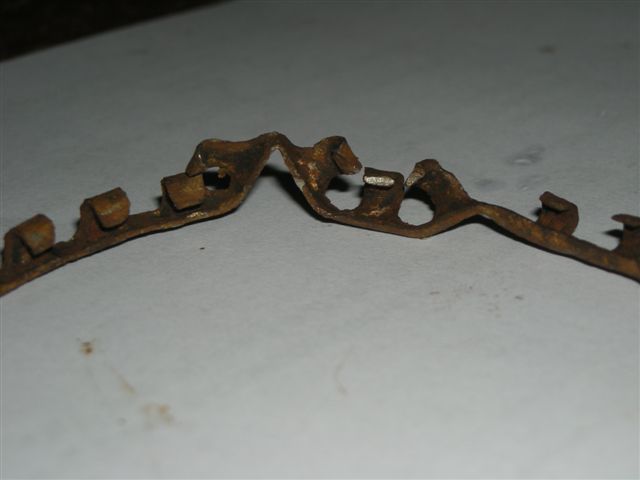
At about 9'o'clock.
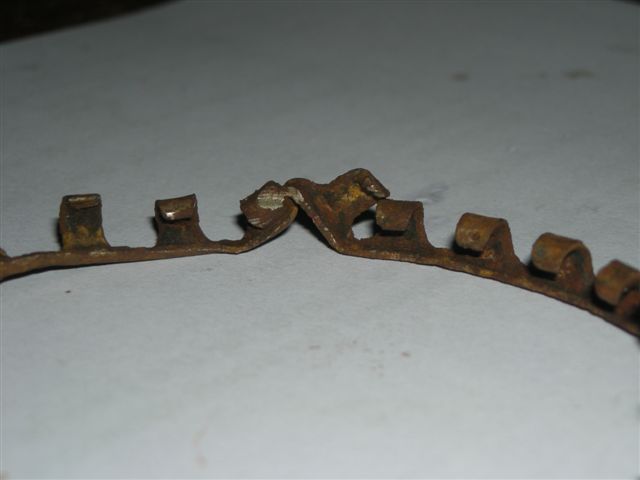
At about 5'o'clock.
